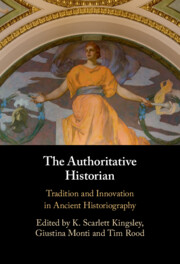Book contents
- The Authoritative Historian
- The Authoritative Historian
- Copyright page
- Dedication
- Contents
- Contributors
- Preface
- Abbreviations
- Introduction
- Part I Myth, Fiction, and the Historian’s Authority
- Chapter 1 Seven Types of Fiction in the Greek Historians
- Chapter 2 Folktale and Local Tradition in Charon of Lampsacus
- Chapter 3 Mythical and Historical Time in Herodotus
- Chapter 4 Myth and History in Livy’s Preface
- Part II Dislocating Authority in Herodotus’ Histories
- Part III Performing Collective and Personal Authority
- Part IV Generic Transformations
- Part V Innovation within Tradition
- Bibliography
- Index Locorum
- General Index
Chapter 2 - Folktale and Local Tradition in Charon of Lampsacus
from Part I - Myth, Fiction, and the Historian’s Authority
Published online by Cambridge University Press: 02 December 2022
- The Authoritative Historian
- The Authoritative Historian
- Copyright page
- Dedication
- Contents
- Contributors
- Preface
- Abbreviations
- Introduction
- Part I Myth, Fiction, and the Historian’s Authority
- Chapter 1 Seven Types of Fiction in the Greek Historians
- Chapter 2 Folktale and Local Tradition in Charon of Lampsacus
- Chapter 3 Mythical and Historical Time in Herodotus
- Chapter 4 Myth and History in Livy’s Preface
- Part II Dislocating Authority in Herodotus’ Histories
- Part III Performing Collective and Personal Authority
- Part IV Generic Transformations
- Part V Innovation within Tradition
- Bibliography
- Index Locorum
- General Index
Summary
The study of traditional narrative originated largely as a result of the combined influence of two of the most momentous historical phenomena of the nineteenth century, namely, romanticism and the rise of the nation-state. The first modern collection of folktales, the Kinder- und Hausmärchen, edited by the brothers Jacob and Wilhelm Grimm, started coming out at the beginning of 1813, months before the Völkerschlacht in Leipzig in October 1813, which marked the end of Napoleon’s Empire. It is more than a mere coincidence that the ‘battle of the nations’ received its nickname from the German romantic literate Achim von Arnim, who was also one of the original sponsors of the Grimm enterprise.1 The ultimate goal of the collection was transparent in the very technique adopted by the brothers: by gathering stories directly from the voice of oral informants whenever possible and including data on the informant and on the time and place of the recording, they intended to document with philological accuracy the spirit of the German people in the most pristine and least adulterated form possible. Here, however, comes a striking paradox, for soon the Grimm brothers themselves realized that many of the stories they had collected found close parallels far away in time and space – so much for the German spirit. Their response to this finding, in extreme simplification, consisted in connecting folktales to an original corpus of Indo-European myths that had devolved into folktales over time and spread all over Indo-European cultural areas.
- Type
- Chapter
- Information
- The Authoritative HistorianTradition and Innovation in Ancient Historiography, pp. 41 - 61Publisher: Cambridge University PressPrint publication year: 2023

